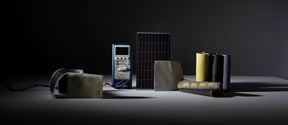The results of the Sun-powered Textiles project will be presented as showcase jackets
A showcase jacket is a tangible result of the Sun-powered Textiles project
There are many applications in wearable technology, smart textiles and e-textiles that are already available and widely used in sports, health and wellbeing, and workwear. All the sensors, devices and visual effects added into textiles need a power source. Solar cells can replace the traditional batteries in some applications and make smart textiles energy autonomous.
The logical way of integrating photovoltaics is to attach solar cells on the front surface of a textile to ensure maximum energy harvesting. That significantly compromises the aesthetics: a black or silver coloured solar cell attached on top of a fabric dominates the look of the textile or garment.
In the Sun-powered Textiles project, the solution is to hide the solar cells underneath a textile layer. By visually concealing the solar cell, it enables a broader freedom of design, while still producing enough energy for powering wearable devices. The solution is inspired by the facades in building-integrated photovoltaics.

The main objectives in the project are
We are researching textile materials that will visually hide the solar cell, and simultaneously, allow the ambient light to be transmitted through to the solar cell. To ensure the commercial feasibility, we need to confirm that the solar cells meet the requirements of textile-product-integration. This includes, for example, the consideration of physical form factors that are suitable for textile products, durability in textile processing, care and use, and sufficiently high efficiency in the end-use lighting conditions. The goal is to provide guidelines for industrially scalable solar cell textile design and business opportunities for energy-autonomous e-textiles powered by photovoltaics.
In the Sun-powered Textiles project, the main application for solar cells in professional workwear and smart textiles aims to improve the safety of employees. Academic partners from Aalto University, Department of Design and Department of Applied Physics, provide the practical knowledge about textile materials, design and production combined with technical and physical basis for the photovoltaic phenomenon. The industrial partners Foxa Oy and Lindström Oy bring in the perspective of textile end-users, and the electronics company Haltian Oy provides hardware and software solutions for the project needs. Close collaboration with the companies allows us to identify and focus on the key research needs and challenges that would facilitate commercial utilization of the results. The co-innovation project is financed by Business Finland.
Learn more:
The Sun-powered Textiles team:
Department of Design (Aalto University):
Elina Ilén, Project lead (design) (Textile technology, textile electronics design and manufacture), co-advisor for Bettina’s and Zuzana’s M.A. theses
Elina Palovuori, Coordinator, daily support of design and research, (textile materials, textile technology)
Bettina Blomstedt, M.A. Thesis worker, research assistant (Textile design, development of knitted textiles)
Zuzana Zmatekova, M.A. Thesis worker (Textile design, development of woven textiles),
Maarit Salolainen, Supervisor for Bettina’s and Zuzana’s M.A. theses, Co-advisor for Zuzana’s M.A. thesis
Department of Applied Physics (Aalto University):
Janne Halme, Project lead (physics), Project PI (physics)
Farid Elsehrawy, project manager, post-doctoral researcher (Solar cell textile optics and photonics, energy harvesting electronics)
Linda Wederhorn, M.Sc. thesis worker (Textile - solar cell performance characterization and energy harvesting analysis)
Pinja Helasuo, B.Sc. thesis worker, research assistant (Solar cell textile modeling and characterization)
Jaakko Eskola, B.Sc. thesis worker, research assistant (Photographic colorimetry)

A showcase jacket is a tangible result of the Sun-powered Textiles project

The research results of the Sun-powered Textiles project will be presented

Researchers of the Sun-Powered Textiles project answer the most frequently (un)asked questions about their textile-integrated solar cells.

The discrete nature of the cells protects them – and makes the clothes more attractive, the physics and design researchers say. Promising applications include work and outdoor clothing, and curtains which react to changes in the amount of light.